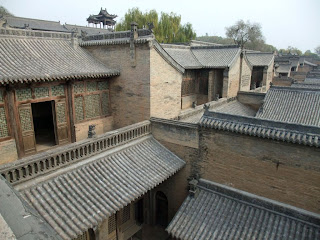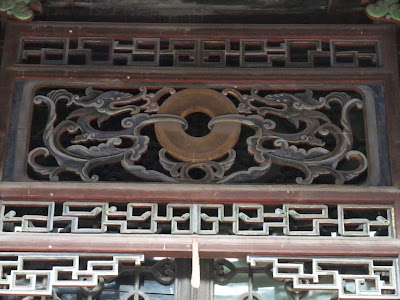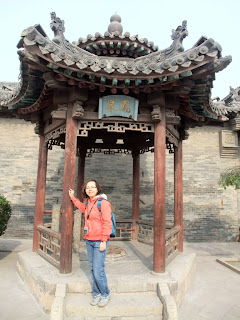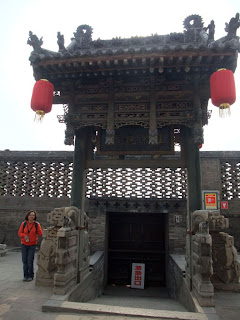
The West Courtyard in Wang's Compound, originally named as Hengzhen-Bao (恒祯堡), was informally known as Red Gate Castle (Hongmen-Bao 红门堡) as it has only one gate facing the main street, that painted in red. The castle is divided into several parts by a vertical street with three alleys, in a shape of rectangular, laid out in the form of Chinese character Wang (王). Most of its structures were constructed during the reign of Emperor Qianlong (1735-1796) in Qing Dynasty. The architectural complex of Hongmen-Bao consists of 27 main courtyards and has been nicknamed as Museum of Wang Family. The Museum Hall at North East of Hongmen-Bao is the only example of Wang's culture and a singular source for researching Wang's clan throughout the world.



Wang was one of the four Lingshi well known clans in Qing Dynasty who profited from trades during the time when Shanxi was very famous for its trading companies and remittance houses. The large family compounds built by these wealthy Jin merchants had 100s and 100s of rooms and displayed exquisite workmanship. Among the four, Qiao's is the most popular as it was the venue of the film Raising The Red Lantern (红灯笼高高照), shoot by Zhang Yimou. Wang's Compound is the largest and most grandeur in terms of size and volume of delicate and elegant architectures gathered.


Wang's compound had been built successively during the period of the four emperors Kangxi, Yongzheng, Qialong and Jiaqing of Qing Dynasty (1644-1911)


The different styled courtyards in Hongmen-Bao are splendid and delicate.


The arrangement of courtyard within a courtyard, door after door, house above house, creates a labyrinthine world.



The cave styled living areas in most courtyards are connected by corridors and there are rooms on top of it.




The wealth of Wang's Family was collected from land farming and mostly from trading business they expanded. The wealth they had also eventually provided opportunity for them to become ministry officials.



Hongmen-Bao was facilitated by a main street measured 133 meter in length and 3 1/2 meter in width, running lengthways from north to south and intersected by three crosswise alleys of west and east direction.



Covering an area of 25,000 sq. meter, the Complex size of West Courtyard (Hongmen-Bao)was much larger than East Courtyard (Gaojia-Ya)



To have a good survey on the entire compound, there is no way than climbing to the very top of the cascading fortress.



The top of the fort offers a spectacular panoramic view of the compound and loess plateau in the backyard.



The wall of the castle is about two meter thick and with height 8 feet externally and 4 feet internally.


Cave dwelling village behind the fortress.


Cave dwelling village.



The peasant farmers living here are like millions of others at loess Plateau in North China, have made homes out of man-made caves for generation.



Cave dwellings



The stunning architectural details and its national treasure that had survived to this date.


The garden



The Garden


The living complex after long been vacated by Wang Clan for decades, was once displaced by the commune of impoverished farmers under the regime of Chairman Mao during 1950s when the communists party was first established.


From its main street, start exploring into the maze of its hundreds of rooms in Hongmen-Bao.




The 133 meter long main street of Hongmen-Bao was paved with cobbled stone .




The cobbled street was named as Longlin-Jie (龙鳞街) which literally means dragon scales road as Hongmen-Bao not only built in the form of their family name Wang but also implies the shape of a dragon.




A web of interconnecting Shiheyuan (四合院)and courtyards stretching all the way up the sloping fortress.




The elegant decorations with wood carvings at the door frame and roofing eaves vividly reflect the luxurious life of Wang family at that time.



Fantastic collection also covers work in stone and brick.


It was said that during the heyday of Wang's clan in the late 18th century, there were an estimation of 8000 rooms in their courtyard.


Taufoo making utensils were still kept in this kitchen to remember the living earning equipment of their ancestors who were taufoo seller before extended to do business and became rich.


If you are interested in classical Chinese architecture, Hongmen-Bao is a wondrous place to visit.



Hengzhen-Bao (恒祯堡) was the original name of Western Courtyard. People used to call it Hongmen-Bao as it has only one gate and that was painted in red. The inscription of the three Chinese character of Hengzhen-Bao at a framed greenish stone is still highly hanged at the front door at the center of the main gate site.


The West Courtyards (Hongmen-Bao) and East Courtyards (Gaojia-Ya) are linked by a stone bridge over a moat with length 108 meter by width 105 meter.


The two main wells of Wang's family located at the front part of Hongmen-Bao were classically named as Long-Zhe (龙泽) and Feng-Quan (凤泉) which means Dragon Pond and Phoenix Spring. There's still water from the wells.




An elegant huge brick carving screen and its red painted gate at Hongmen-Bao.



The walled town of Wang's Living Compound is absolutely colossal in size. Study well before exploration as there is no indication in Chinese or any other languages on how to navigate into its 1118 rooms in the courtyards.



Lines of shops and restaurants along the road entering into the destination of Wang's Compound.



It was rather inconvenient for independent tourists other than joining an organized group tour or like us hire a private car as there was no regular public transportation to go direct to Wang's Compound. We paid 300rmb for a car plus driver to take us there and spent half a day in Wang's Compound, half a way visiting other surrounding historic spots. By the time he sent us back to hotel, it was already dark.



From Pingyao to Lingshi and from Lingshi to Qingsheng, though the distance is not too far but it took about two hours drive and there were many historical sites along the way. It was indeed an interesting trip.


No comments:
Post a Comment